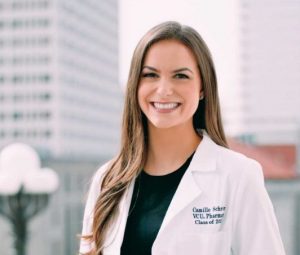Living with little-known disorder Ehlers-Danlos sparked Miss Virginia’s love of science
By Emiley Bagalawis
VCU School of Pharmacy News
Camille Schrier won the title of Miss Virginia in June with the help of her science-related talent exhibition — a demonstration of the catalytic conversion of hydrogen peroxide that created a dramatic burst of colored foam on the pageant stage.
That win and the video of her demonstration led millions to see her story on TV news reports, social media and websites. She has been hailed for breaking stereotypes and as a role model for young women.
But most people have no idea of the disorder that helped inspire her career in science.
Camille is living with Ehlers-Danlos Syndrome, a genetic condition that affects body tissue, joints and blood vessels. She was diagnosed when she was 11.
“It definitely got me interested in science and medicine because there’s no treatment for this right now,” Camille says. “There was a lot of genetic information regarding EDS and genetics was something I was always really interested in. This was a further interest, in terms of genetics, for me to look at and think about how that could help us diagnose people.”
Camille’s family noticed something was wrong as soon as she was born: Camille was born with her hips dislocated. She also fell a lot as a child and was prone to injuries because EDS can make people less stable. She found out she had EDS when she went to see an orthopedic surgeon for scoliosis, which her family learned was caused by her EDS.
She lives with pain from the condition. Her level of pain varies in intensity from day to day, sometimes making her feel like she has the flu.

“It’s not like shooting, burning or electric pain. It’s kind of a dull chronic achiness that I get frequently,” she says. “It … rarely interferes with my everyday life. But it’s definitely a reminder that it’s there.”
EDS affects about 1 in 5,000 people. There are 13 different types, classified based on the symptoms and signs that patients show. Common symptoms include loose and unstable joints that can lead to frequent dislocations, joint pain, fragile skin that can bruise easily, and poor wound healing. EDS can cause early onset osteoarthritis, scoliosis, musculoskeletal pain, arterial/intestinal/uterine fragility or rupture, poor muscle tone and gum disease.
Camille has classic EDS, which affects the genes in her type V collagen. Symptoms include joint hypermobility, skin hyperextensibility and skin fragility that leads to scarring and bruising.
It is a genetic condition. Camille and her mother, Cheryl Schrier, were both diagnosed at the same time. Cheryl Schrier says she would get injured frequently as a teenager but was consistently blown off as being “overdramatic.”
“Camille was experiencing some of the same [experiences I had],” Cheryl says. “Her swim coach told her she was ‘trying to get out of the hard work’ when her shoulder dislocated repeatedly during backstroke practices, and field hockey coaches told her to ‘walk off’ ankle subluxations and hand injuries.”
The Schriers’ experience rings true for Tahnee N. Causey, a genetic counselor and assistant director of the VCU Genetic Counseling Program who has worked with many patients with EDS.
Friends, co-workers and even physicians often do not understand a disorder like EDS that has few visible signs but that can cause real injury and pain, Causey says. Common symptoms of EDS include migraine, joint pain, gastrointestinal distress, poor wound healing and postural orthostatic tachycardia syndrome, or POTS, a circulatory condition in which people become lightheaded and dizzy when they stand up.
It is not unusual for EDS patients to struggle for a long time to convince doctors that their symptoms are real, Causey adds: “For some of our patients it’s a real validation that they have a diagnosis.”
Causey, who says her office evaluates about 10 patients a week who show signs that may mean they have the disorder, suspects it is more common than even many experts think.
Starting in September 2019, VCU Health is beginning a twice-monthly clinic with practitioners from different medical disciplines to help treat patients with EDS.
Camille Schrier says she hopes that speaking about her condition helps people, particularly healthcare professionals and pharmacy students, understand that EDS is “wildly misdiagnosed” and more common than people realize since there are many different strains of the disorder.
“I have something that causes me pain constantly and causes me injury and chronic fatigue sometimes,” she says. “That’s something I deal with, and there are many other people that have illnesses that are not obvious.”
Camille has taken a one-year leave of absence from her Pharm.D. studies. She is currently travelling the state, sharing her STEM platform as Miss Virginia. She will compete in the Miss America pageant in September.
To learn more about Ehlers-Danlos Syndrome visit https://www.ehlers-danlos.com.
Note: This article was edited on Aug. 8, 2019, to add information from an interview with Tahnee Causey.
